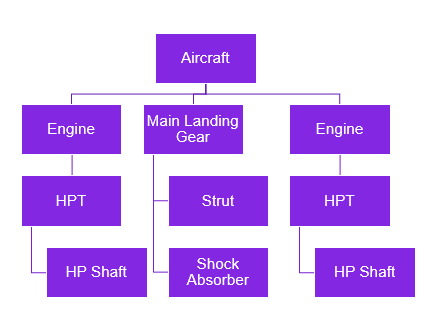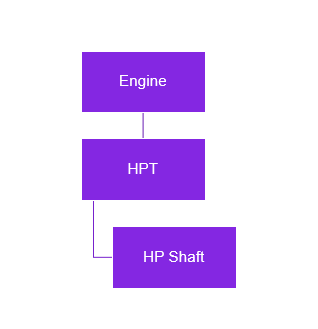Life Limits Concept in IFS Fleet and Asset Management
What are Life Limits
Especially in the Aviation Industry, certain components are considered very critical for the safe operation of the aircraft. Such components will oftentimes have a hard life limit defined. A hard life limit means that it is not allowed to use the component after the life limit has been reached; it drops dead. It is normally not possible to rework or overhaul these components back into an operational state.
A component with a life limit is referred to as a Life Limited Part (LLP).
What are Stress Ratings
How much wear and tear a component is exposed to is dependent on how it is
used. For instance, a component used in a high-power engine will be exposed
to more wear than the same component used in a low-power engine. This means
that the life limit can be longer in the low-power engine than in the high-power
engine. In IFS/Fleet and Asset Management, this is managed using what is called
Stress Ratings. In other words, stress ratings is a way of defining
different life limits for the same component, based on the stress it is operated
under.
How to define Stress Ratings
How stress ratings can be defined is illustrated through the following examples:
Example A: Stress ratings defined on the sub assembly level
The diagram below shows an aircraft that has three sub assemblies: two engines and one main landing gear (MLG). In the engines, the HP shaft is an LLP, while in the MLG, the strut is an LLP. The engines can operate with three different max thrust; 22,000 lbs, 25,000 lbs, and 28,000 lbs. The MLG is certified for a 22 ton max landing weight. This means, in this aircraft model, there are four different stress ratings, applying to the different LLPs. The life limits for the LLPs will depend on the LLP part number and the stress rating.

The requirement is that the engine stress ratings should only apply to the HP shaft, and the MLG stress rating should only apply to the strut.
- First, the template structure or master configuration must be defined.
- Note that it is recommended to define all assemblies and sub assemblies as separate templates, while it is not recommended to do so for the piece parts on the lowest level. For the example aircraft model, this will give Template Parts for the three first levels, but not for the fourth. For more information on defining the master configuration, refer the Serial Structure Template document.
- Once the template structure is defined, the stress ratings can be registered.
In this example, the requirement is to define the stress ratings on the
most unique level, and not mix stress ratings for the sub assemblies. Therefore
the stress ratings will be defined on the second level.
- Engine - Three stress ratings 22', 25', and 28' will be registered. (Note that if the engine is defined as a separate template, the stress ratings only need to be defined once per engine part number).
- MLG - One stress rating, 22t, will be registered
Example B: Stress ratings defined on the topmost level
In this example, assume you are only working with an engine. The template structure or master configuration for the engine will consist of the two first levels defined as separate templates, while the lowest level is not. In here, the stress rating will be defined on the top level, i.e., the engine.

How to define Life Limits
Life limits are defined by the combination of stress rating and LLP part number.
When setting up life limits for each LLP, the applicable stress ratings are retrieved. This is done by traversing each template structure that the LLP is defined within. When a template part with stress ratings defined are found, these stress ratings are retrieved to the LLP part number. When a template part with stress ratings defined is found, the traversing is stopped.
In Example A and B, for the HP Shaft, the three stress ratings, 22', 25', 28', which are defined for the engine will be retrieved to the LLP. Note, in Example A, if the stress ratings were defined at the aircraft level, the stress rating for the MLG would also be retrieved (in this case, this would be incorrect since the MLG stress rating does not apply to the HP shaft).
For the MLG strut, the stress rating 22t will be retrieved to the LLP.
Once the stress ratings are fetched for the LLP, life limits can be defined in the applicable operational parameter. For the HP shaft, let's assume following life limits are set (this will be used later on to explain how remaining life is calculated.)
| Stress Rating | Life Limit (engine hours) |
| 22' | 10,000 |
| 25' | 20,000 |
| 28' | 30,000 |
How are LLPs handled in IFS Fleet and Asset Management
Once the stress ratings and life limits are set up, there is only one thing you need to remember to do: Change stress ratings when applicable. The reason this needs to be done is the same serialized component can be moved between structures with different stress ratings, or the structure can be changed to another stress rating. For example, once the HP shaft is overhauled, it can be installed in an engine with a different max thrust than before, or the engine can be re-rated to a different max thrust.
- If the LLP is moved to a structure with a different stress rating, this is updated automatically
- If the stress rating of the structure is changed, this will have to be changed manually
When operational loggings are performed, the system will automatically log for which stress rating the logging was done. The accumulated life for each stress rating and each LLP is tracked.
Calculating the Remaining Life
Calculation of remaining life is essential to LLP management, since it is not allowed to operate the asset after the life limit is passed.
Remaining life is calculated using a formula called the Miner's Rule.
RL = LLSR1 (1-USR1/LLSR1 - USR2/LLSR2)
Where:
RL = Remaining Life
LLSR1 = Life Limit
Stress Rating 1
USR1 = Utilization Stress Rating 1
LLSR2 = Life Limit
Stress Rating 2
USR2 = Utilization Stress Rating 2
For the HP shaft in the example aircraft model, let's assume the following accumulated utilization values are logged.
| Stress Rating | Life Limit (engine hours) | Acc. Utilization |
| 22' | 10,000 | 2,500 |
| 25' | 20,000 | 4,000 |
| 28' | 30,000 | 1,500 |
The remaining life for the HP shaft, under the stress rating 22' is then calculated as follows:
10,000 * (1 – 2,500/10,000 – 4,000/20,000 – 1,500/30,000)
= 10,000 *
(1 - 0.25 – 0.20 – 0.05)
= 10,000 * 0.50
= 5,000
Remaining life for the other stress ratings will be calculated in similar manner.